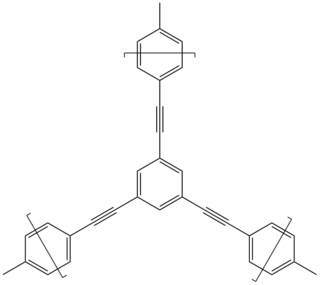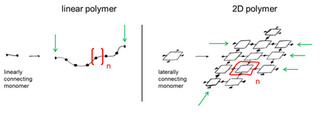Related Research Articles
An artificial membrane, or synthetic membrane, is a synthetically created membrane which is usually intended for separation purposes in laboratory or in industry. Synthetic membranes have been successfully used for small and large-scale industrial processes since the middle of the twentieth century. A wide variety of synthetic membranes is known. They can be produced from organic materials such as polymers and liquids, as well as inorganic materials. Most commercially utilized synthetic membranes in industry are made of polymeric structures. They can be classified based on their surface chemistry, bulk structure, morphology, and production method. The chemical and physical properties of synthetic membranes and separated particles as well as separation driving force define a particular membrane separation process. The most commonly used driving forces of a membrane process in industry are pressure and concentration gradient. The respective membrane process is therefore known as filtration. Synthetic membranes utilized in a separation process can be of different geometry and flow configurations. They can also be categorized based on their application and separation regime. The best known synthetic membrane separation processes include water purification, reverse osmosis, dehydrogenation of natural gas, removal of cell particles by microfiltration and ultrafiltration, removal of microorganisms from dairy products, and dialysis.

Gas mixtures can be effectively separated by synthetic membranes made from polymers such as polyamide or cellulose acetate, or from ceramic materials.
A proton-exchange membrane, or polymer-electrolyte membrane (PEM), is a semipermeable membrane generally made from ionomers and designed to conduct protons while acting as an electronic insulator and reactant barrier, e.g. to oxygen and hydrogen gas. This is their essential function when incorporated into a membrane electrode assembly (MEA) of a proton-exchange membrane fuel cell or of a proton-exchange membrane electrolyser: separation of reactants and transport of protons while blocking a direct electronic pathway through the membrane.

Nanofibers are fibers with diameters in the nanometer range. Nanofibers can be generated from different polymers and hence have different physical properties and application potentials. Examples of natural polymers include collagen, cellulose, silk fibroin, keratin, gelatin and polysaccharides such as chitosan and alginate. Examples of synthetic polymers include poly(lactic acid) (PLA), polycaprolactone (PCL), polyurethane (PU), poly(lactic-co-glycolic acid) (PLGA), poly(3-hydroxybutyrate-co-3-hydroxyvalerate) (PHBV), and poly(ethylene-co-vinylacetate) (PEVA). Polymer chains are connected via covalent bonds. The diameters of nanofibers depend on the type of polymer used and the method of production. All polymer nanofibers are unique for their large surface area-to-volume ratio, high porosity, appreciable mechanical strength, and flexibility in functionalization compared to their microfiber counterparts.

Self-healing materials are artificial or synthetically created substances that have the built-in ability to automatically repair damages to themselves without any external diagnosis of the problem or human intervention. Generally, materials will degrade over time due to fatigue, environmental conditions, or damage incurred during operation. Cracks and other types of damage on a microscopic level have been shown to change thermal, electrical, and acoustical properties of materials, and the propagation of cracks can lead to eventual failure of the material. In general, cracks are hard to detect at an early stage, and manual intervention is required for periodic inspections and repairs. In contrast, self-healing materials counter degradation through the initiation of a repair mechanism that responds to the micro-damage. Some self-healing materials are classed as smart structures, and can adapt to various environmental conditions according to their sensing and actuation properties.

Nanoporous materials consist of a regular organic or inorganic bulk phase in which a porous structure is present. Nanoporous materials exhibit pore diameters that are most appropriately quantified using units of nanometers. The diameter of pores in nanoporous materials is thus typically 100 nanometers or smaller. Pores may be open or closed, and pore connectivity and void fraction vary considerably, as with other porous materials. Open pores are pores that connect to the surface of the material whereas closed pores are pockets of void space within a bulk material. Open pores are useful for molecular separation techniques, adsorption, and catalysis studies. Closed pores are mainly used in thermal insulators and for structural applications.
Nanotube membranes are either a single, open-ended nanotube(CNT) or a film composed of an array of nanotubes that are oriented perpendicularly to the surface of an impermeable film matrix like the cells of a honeycomb. 'Impermeable' is essential here to distinguish nanotube membrane with traditional, well known porous membranes. Fluids and gas molecules may pass through the membrane en masse but only through the nanotubes. For instance, water molecules form ordered hydrogen bonds that act like chains as they pass through the CNTs. This results in an almost frictionless or atomically smooth interface between the nanotubes and water which relate to a "slip length" of the hydrophobic interface. Properties like the slip length that describe the non-continuum behavior of the water within the pore walls are disregarded in simple hydrodynamic systems and absent from the Hagen–Poiseuille equation. Molecular dynamic simulations better characterize the flow of water molecules through the carbon nanotubes with a varied form of the Hagen–Poiseuille equation that takes into account slip length.

A membrane is a selective barrier; it allows some things to pass through but stops others. Such things may be molecules, ions, or other small particles. Membranes can be generally classified into synthetic membranes and biological membranes. Biological membranes include cell membranes ; nuclear membranes, which cover a cell nucleus; and tissue membranes, such as mucosae and serosae. Synthetic membranes are made by humans for use in laboratories and industry.

The thiol-yne reaction is an organic reaction between a thiol and an alkyne. The reaction product is an alkenyl sulfide. The reaction was first reported in 1949 with thioacetic acid as reagent and rediscovered in 2009. It is used in click chemistry and in polymerization, especially with dendrimers.

Conjugated microporous polymers (CMPs) are a sub-class of porous materials that are related to structures such as zeolites, metal-organic frameworks, and covalent organic frameworks, but are amorphous in nature, rather than crystalline. CMPs are also a sub-class of conjugated polymers and possess many of the same properties such as conductivity, mechanical rigidity, and insolubility. CMPs are created through the linking of building blocks in a π-conjugated fashion and possess 3-D networks. Conjugation extends through the system of CMPs and lends conductive properties to CMPs. Building blocks of CMPs are attractive in that the blocks possess broad diversity in the π units that can be used and allow for tuning and optimization of the skeleton and subsequently the properties of CMPs. Most building blocks have rigid components such as alkynes that cause the microporosity. CMPs have applications in gas storage, heterogeneous catalysis, light emitting, light harvesting, and electric energy storage.

Andrew Bruce Holmes is an Australian and British senior research chemist and professor at the Bio21 Institute, Melbourne, Australia, and the past President of the Australian Academy of Science. His research interests lie in the synthesis of biologically-active natural products and optoelectronic polymers.

A two-dimensional polymer (2DP) is a sheet-like monomolecular macromolecule consisting of laterally connected repeat units with end groups along all edges. This recent definition of 2DP is based on Hermann Staudinger's polymer concept from the 1920s. According to this, covalent long chain molecules ("Makromoleküle") do exist and are composed of a sequence of linearly connected repeat units and end groups at both termini.

Interfacial polymerization is a type of step-growth polymerization in which polymerization occurs at the interface between two immiscible phases, resulting in a polymer that is constrained to the interface. There are several variations of interfacial polymerization, which result in several types of polymer topologies, such as ultra-thin films, nanocapsules, and nanofibers, to name just a few.
Niveen M. Khashab is a Lebanese chemist and an associate Professor of chemical Sciences and engineering at King Abdullah University of Science and Technology in Saudi Arabia since 2009. She is a laureate of the 2017 L'Oréal-UNESCO Awards for Women in Science "for her contributions to innovative smart hybrid materials aimed at drug delivery and for developing new techniques to monitor intracellular antioxidant activity." She is also a fellow of the Royal Chemical Society, and a member of the American Chemical Society.

In biochemistry, biomolecular condensates are a class of membrane-less organelles and organelle subdomains, which carry out specialized functions within the cell. Unlike many organelles, biomolecular condensate composition is not controlled by a bounding membrane. Instead, condensates can form and maintain organization through a range of different processes, the most well-known of which is phase separation of proteins, RNA and other biopolymers into either colloidal emulsions, gels, liquid crystals, solid crystals or aggregates within cells.
Polymers of intrinsic microporosity (PIMs) are a unique class of microporous material developed by research efforts led by Neil McKeown, Peter Budd, et al. PIMs contain a continuous network of interconnected intermolecular voids less than 2 nm in width. Classified as a porous organic polymer, PIMs generate porosity from their rigid and contorted macromolecular chains that do not efficiently pack in the solid state. PIMs are composed of a fused ring sequences interrupted by Spiro-centers or other sites of contortion along the backbone. Due to their fused ring structure PIMs cannot rotate freely along the polymer backbone, ensuring the macromolecular components conformation cannot rearrange and ensuring the highly contorted shape is fixed during synthesis.

Seth B. Darling is the Chief Science & Technology Officer of the Advanced Energy Technologies Directorate at Argonne National Laboratory. He previously served as director of the Center for Molecular Engineering, a research and development organization partnered with the University of Chicago focusing on advanced materials for cleaning water, quantum information science, and polymer science. Darling is also a senior scientist at both the U.S. Department of Energy’s (DOE) Argonne National Laboratory and the University of Chicago’s Pritzker School of Molecular Engineering. He also directs the Advanced Materials for Energy-Water Systems (AMEWS) Center, a DOE Energy Frontier Research Center formed in 2018.

Wendy Lee Queen is an American chemist and material scientist. Her research interest focus on development design and production of hybrid organic/inorganic materials at the intersection of chemistry, chemical engineering and material sciences. As of 2020 she is a tenure-track assistant professor at the École polytechnique fédérale de Lausanne (EPFL) in Switzerland, where she directs the Laboratory for Functional Inorganic Materials.
2,6-Diformylpyridine is an organic compound with the formula C5H3N(CHO)2, and typically appears as a solid powder at room temperature. The molecule features formyl groups adjacent to the nitrogen of pyridine. The compound is prepared by oxidation of 2,6-dimethylpyridine.

Fred Wudl is an American materials scientist, academic researcher. He is a Professor Emeritus in the Department of Materials Engineering at the University of California, Santa Barbara.
References
- 1 2 3 4 5 6 "Peter Martin Budd (Biography)" . Retrieved 14 June 2020.
- 1 2 3 ORCid. "Peter Budd" . Retrieved 14 June 2020.
- 1 2 3 University of Manchester. "Prof. Peter Budd" . Retrieved 14 June 2020.
- 1 2 3 University of Manchester. "Better World Awards 2020" . Retrieved 14 June 2020.
- 1 2 3 "Peter Budd (Google Scholar)" . Retrieved 1 June 2022.
- ↑ Budd, Peter Martin (1981). The Synthesis and Properties of Polypeptides (PhD thesis). ProQuest 2265908951.
 [ non-primary source needed ]
[ non-primary source needed ] - ↑ University of Manchester. "Peter Budd Activities" . Retrieved 14 June 2020.
- ↑ St. Andrew's Church, Cheadle Hulme. "St. Andrew's Church Ministry team" . Retrieved 14 June 2020.
- ↑ Budd, Peter M.; Ghanem, Bader S.; McKeown, Neil B.; Makhseed, Saad; Msayib, Kadhum J.; Tattershall, Carin E. (2004). "Polymers of intrinsic microporosity (PIMs): robust, solution-processable, organic nanoporous materials". Chem. Comm. (2): 230–231. doi:10.1039/B311764B. PMID 14737563.[ non-primary source needed ]
- ↑ Budd, Peter M.; McKeown, Neil B. (2006). "Polymers of intrinsic microporosity (PIMs): organic materials for membrane separations, heterogeneous catalysis and hydrogen storage". Chem. Soc. Rev. 35 (8): 675–683. doi:10.1039/B600349D. PMID 16862268.[ non-primary source needed ]
- ↑ Budd, Peter M.; McKeown, Neil B. (2010). "Exploitation of Intrinsic Microporosity in Polymer-Based Materials". Macromolecules. 43 (12): 5163–5176. Bibcode:2010MaMol..43.5163M. doi:10.1021/ma1006396.[ non-primary source needed ]
- ↑ Budd, Peter M.; Ghanem, Bader S.; McKeown, Neil B.; Reynolds, Kevin J.; Msayib, Kadhum J.; Tattershall, Carin E.; Fritsch, Detlev (2005). "Gas separation membranes from polymers of intrinsic microporosity". Journal of Membrane Science. 251 (1–2): 263–269. doi:10.1016/j.memsci.2005.01.009.[ non-primary source needed ]
- ↑ Budd, Peter M.; Ghanem, Bader S.; McKeown, Neil B.; Elabas, Elssalhen S.; Msayib, Kadhum J.; Tattershall, Carin E.; Makhseed, Saad; Wang, Dong (2004). "Solution-processed, organophilic membrane derived from a polymer of intrinsic microporosity". Adv. Mater. 16 (5): 456–459. Bibcode:2004AdM....16..456B. doi:10.1002/adma.200306053. S2CID 95540635.[ non-primary source needed ]
- ↑ Comesaña-Gándara, Bibiana; Bezzu, C. Grazia; McKeown, Neil B.; Chen, Jie; Rose, Ian; Ferrari, Maria-Chiara; Carta, Mariolino; Esposito, Elisa; Fuoco, Alessio; Jansen, Johannes C. (2019). "Redefining the Robeson upper bounds for CO2/CH4 and CO2/N2 separations using a series of ultrapermeable benzotriptycene-based polymers of intrinsic microporosity". Energy & Environmental Science. 16 (9): 2733–2740. doi: 10.1039/C9EE01384A . hdl: 20.500.11820/34b25078-6ac2-4530-b1cf-9c179d3e4688 .